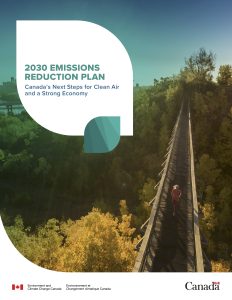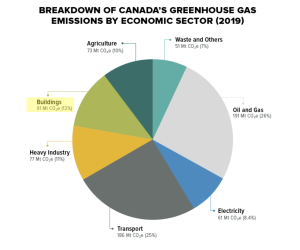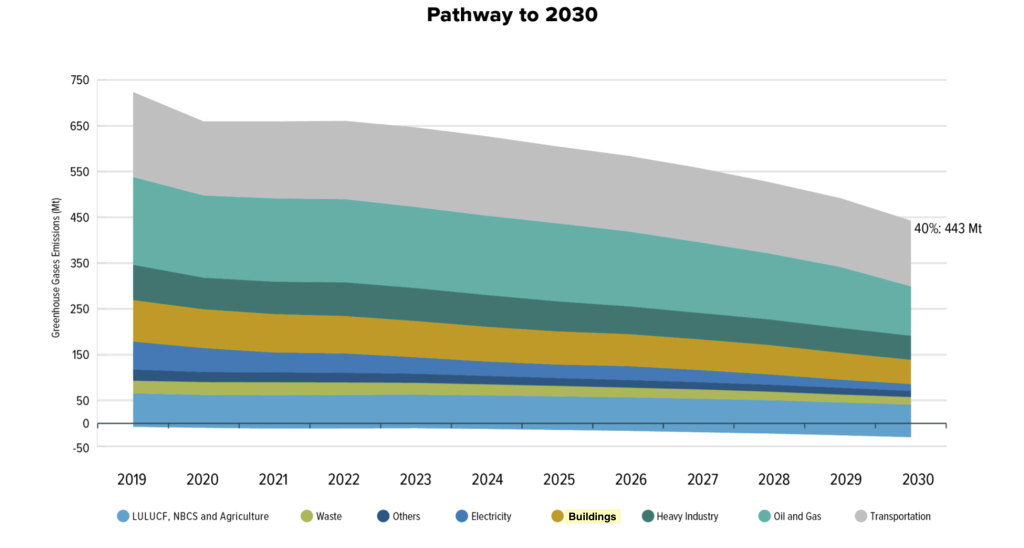
Canada Releases 2030 Emissions Reduction Plan
March 30, 2022 | By HPAC Magazine
The Plan includes $9.1 billion in new investments designed to ensure the country reaches an emissions reduction target of 40 to 45% below 2005 levels by 2030.
 As mandated by the Canadian Net-Zero Emissions Accountability Act put into law in June of 2021, the Minister of Environment was to outline the nation’s emissions reduction plan for 2030 by the end of 2021, but that report was bumped to the end of March 2022, and now the plan has been revealed.
As mandated by the Canadian Net-Zero Emissions Accountability Act put into law in June of 2021, the Minister of Environment was to outline the nation’s emissions reduction plan for 2030 by the end of 2021, but that report was bumped to the end of March 2022, and now the plan has been revealed.
The 2030 Emissions Reduction Plan: Canada’s Next Steps for Clean Air and a Strong Economy, released on March 29th by Environment Minister Steven Guilbeault, is a 271-page document that includes $9.1 billion in new investments (to appear in the 2022 Federal Budget) designed to ensure that the country will reduce emissions across the entire economy to reach an emissions reduction target of 40 to 45% below 2005 levels by 2030, and thus put the country on a path to achieve net-zero emissions by 2050, a commitment made as part of the Paris Agreement.
 The report breaks down actions sector by sector ranging from buildings to vehicles to industry and agriculture. Specific to the buildings sector, which directly affects the HVAC/R and plumbing industries, the report acknowledges that Canada’s building sector workforce will need to grow dramatically to meet increasing demand, including professional and trades people in construction, renovation, equipment manufacturing, installation and repair, building maintenance, energy assessment and management.
The report breaks down actions sector by sector ranging from buildings to vehicles to industry and agriculture. Specific to the buildings sector, which directly affects the HVAC/R and plumbing industries, the report acknowledges that Canada’s building sector workforce will need to grow dramatically to meet increasing demand, including professional and trades people in construction, renovation, equipment manufacturing, installation and repair, building maintenance, energy assessment and management.
In addition, the government is developing the $150-million Canada Green Buildings Strategy. “Working with provinces, territories, and other partners, the strategy will build off existing initiatives and set out new policy, programs, incentives, and standards needed to drive a massive retrofit of the existing building stock, and construction to the highest zero-carbon standards.”
The Buildings Strategy will:
-
- Develop a Low Carbon Building Materials Innovation Hub to drive further research, building code reform, and demonstration activities, all promoting the use of lower carbon construction materials (e.g., wood, steel, cement, etc.) in the built environment;
- Develop regulatory standards, and an incentive framework to support the transition off fossil- fuels for heating systems;
- Develop an approach to require EnerGuide labeling of homes at the time of sale, and design a complementary Climate Adaptation Home Rating Program;
- Launch a new Net Zero Building Code Acceleration Fund to accelerate adoption and implementation of the highest performance tiers of the national model energy codes, incentivizing stakeholder participation while addressing persistent challenges in Canada’s codes system and paving the way to a code for alterations for existing buildings;
- Improve federal capacity and technical support to provinces, territories and key stakeholders for the development and adoption of net zero emission codes, and alteration to existing buildings codes; and,
- Develop an approach to increase the climate resilience of the built environment.
In terms of spending, the Plan includes:
- $458.5 million in contribution and loan funding to support the low-income stream of the Greener Homes Loan Program, which will support increased energy savings.
- $33 million to establish a Greener Neighbourhoods Pilot Program, which will retrofit homes or units in up to six communities across the country using an aggregated building retrofits approach based on the Dutch “Energiesprong” model. This support for community-level home retrofits aligns with the Net-Zero Advisory Body’s recommendation to seek out opportunities to decarbonize multiple buildings at once.
- $200 million to support deep retrofits of large buildings through a retrofit accelerator initiative, which will provide help to address barriers to deep retrofits (such as audits or project management).
- $183 million to support a decarbonized and climate resilient construction sector through the development of standards and building codes, the establishment of a Centre of Excellence, research and development activities — including a concrete and cement R&D initiative, timber construction R&D initiative, and multi-sector collaboration challenges — and a procurement challenge.
 To encourage the move away from fossil fuels, the current carbon pricing plan remains in place. The price on carbon started at $20 per tonne of emissions in 2019 – and has been rising at $10 per year to reach $50 in 2022. Starting in 2023, the price will start rising by $15 per year until it reaches $170 per tonne in 2030.
To encourage the move away from fossil fuels, the current carbon pricing plan remains in place. The price on carbon started at $20 per tonne of emissions in 2019 – and has been rising at $10 per year to reach $50 in 2022. Starting in 2023, the price will start rising by $15 per year until it reaches $170 per tonne in 2030.
The government will continue to encourage electrifying more activities—including heating and cooling buildings—and thus acknowledges the country needs to both increase the supply of electricity and ensure that all electricity generation has net-zero emissions.
The Plan includes developing a Clean Electricity Standard (CES) to support a net-zero electricity grid by 2035
The Government of Canada will work with provinces and utilities to establish a Pan-Canadian Grid Council to promote clean electricity infrastructure investments.
Additionally, the Feds will invest an additional $600 million in the Smart Renewables and Electrification Pathways Program to support renewable electricity and grid modernization projects and $250 million to support predevelopment work for large clean electricity projects, in collaboration with provinces.
Canada will continue to update its modelling projections, including in Canada’s next Biennial Report in December 2022 and the first 2030 Emissions Reduction Plan progress report expected in late 2023.




